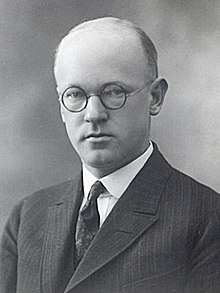Edgar Krahn
Edgar Krahn (1 October [O.S. 19 September] 1894 in Laiuse Parish – 6 March 1961) was an Estonian mathematician.[1]
Edgar Krahn | |
|---|---|
 | |
| Born | 1 October 1894 |
| Died | 6 March 1961 (aged 66) |
| Nationality | Estonian |
| Scientific career | |
| Fields | Mathematics |
Krahn was born in Sootaga (now Laiuse, Jõgeva County), Governorate of Livonia, as a member of the Baltic German minority. He died in Rockville, Maryland, US.
Krahn studied at the University of Tartu and the University of Göttingen. He graduated at Tartu in 1918, received his doctoral degree at Göttingen in 1926, with Richard Courant as his advisor,[2] and his habilitation took place at Tartu in 1928.
He is co-author of the Rayleigh–Faber–Krahn inequality.[3]
Krahn worked in Estonia, Germany, the UK, and the US in the following areas of pure and applied mathematics:
- Differential geometry
- Differential equations
- Bausparmathematik, which is distantly related to insurance mathematics
- Probability theory
- Gas dynamics
- Elasticity theory
See also
References
- Ü. Lumiste, J. Peetre (eds.), Edgar Krahn 1894 – 1961, IOS Press, 1994, ISBN 90-5199-168-1
- Edgar Krahn at the Mathematics Genealogy Project
- http://eom.springer.de/r/r130040.htm Rayleigh–Faber–Krahn inequality
This article is issued from Wikipedia. The text is licensed under Creative Commons - Attribution - Sharealike. Additional terms may apply for the media files.